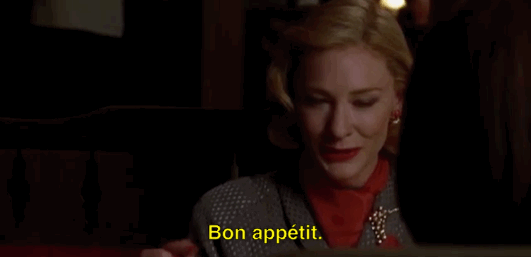REVIEW: THE INTOXICATING SLOW – BURN OF CAROL
By Jerico Lee
Rating 4/5
Patricia Highsmith was an author and bigot. But before her alcohol-fuelled intolerance for non-whites and homosexuals really took off, she wrote the semi- autobiographical The Price of Salt under a pseudonym in 1950. It was original not just because it dealt with love and sex between two women in a shitty era — unlike most literature and pulp at the time, the story doesn’t end with death, arrest or tragedy. Directed by queer legend Todd Haynes, the film version Carol (out in cinemas today) remains loyal to the story’s hopeful message, via a masterful play of subversive itches tempered by a controlled tempo and rigid period setting.
Shot in 16mm by cinematographer Edward Lachman, Carol feels old-world and strangely modern at the same time. It’s dream-like. Not just because of the rich colours, Phillip Glass-like score and super-close up cameras, which constantly shoot the edges of objects, the out of focus visions. The shadows of desire. Time is manipulated in a remarkable way. The pace is slow, but swooning. The atmosphere is heavy. Because our two lead actresses, Rooney Mara and Cate Blanchett play characters deeply attracted to one another yet repressed AF, living in Eisenhower era US, the film is paced with so much restraint, it takes the characters about 70% of the film’s length to even kiss. Imagine the longest foreplay possible — suspenseful, but rich in reward.
Plot-wise, Therese Belivet (Mara) is a mousey, eccentric and talented photographer who comes across society lady, wife and mother, Carol Aird (Blancett) at the counter of the toy store she works at. The two have a sweet and cautious conversation that ends in Carol giving Therese her address (for toy delivery reasons) and accidentally leaving her gloves on the counter (not at all accidentally).
The performances giving by both women can’t be praised enough. Blanchett plays Carol as unknowable, tightly wound, playing the part of seductress yet full of fear herself. While Mara’s Therese is at once shy and self-posessed. Vulnerable and hungry. Both characters communicate largely in furtive glances, in side eye and in silence. Their method of flirting in a time where notions of propriety were deemed more important than food and oxygen consists of winking, stroking one’s hair and face seductively, gently blowing out cigarette smoke and of course, professing their feelings by omission. What’s not said speaks volumes.
Sarah Paulson plays Abby, Carol’s best friend and ex-lover. Carol’s coarse and confused husband Harge (a cheeky combination of hard and large?) is played well by Kyle Chandler. He wants to take away her daughter ‘on moral grounds’, leading to the only obviously high-minded moment of the film but given the rest of its nuance, it’s a necessary one. Upsettingly, although Carol isn’t able to see her daughter Rindy, she still has to brunch with Harge’s parents and attend their inane (yet incredibly well-dressed) parties. In fact, terror and withholding hang in the air above Carol and Therese anytime they’re in public; relatable for anyone who’s dared to fall in love in a less than tolerant environment.
The effect of all this, thanks to the film’s aforementioned ambience is a romance so intoxicating, so profound it can’t even properly be uttered by the people under its spell. It’s obsessive, all-consuming, scary. As the character’s composures are punctuated by more and more longing, their self-control and fear gives way to an explosion of desire and awakening that the whole film — with it’s aesthetic ability to turn every object and every movement into a deeply erotic one — has been leading up to. And only a few short years before American culture itself would be torn apart by a thirst for freedom, first by the civil rights movement and free speech groups. It’s a love story so intense, lumping it in the ‘romance’ genre is a disservice.
It’s rare to see any form of LGBTQIA love displayed on the big screen without aspects of pathologising or disaster. But even seeing it through the straight mainstream gaze, it would be impossible to read Carol as anything other than cerebral and stunning.



